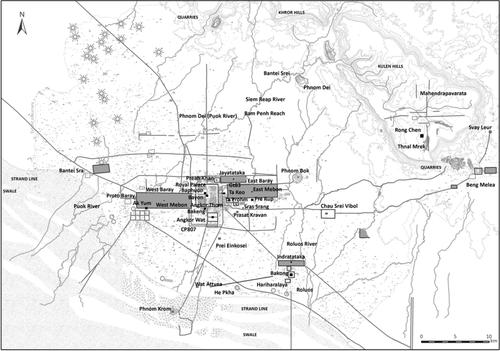当前位置:
X-MOL 学术
›
WIREs Water
›
论文详情
Our official English website, www.x-mol.net, welcomes your
feedback! (Note: you will need to create a separate account there.)
An opinion on issues for future investigation of the water management of Greater Angkor
WIREs Water ( IF 6.8 ) Pub Date : 2020-07-31 , DOI: 10.1002/wat2.1474 Roland Fletcher 1
WIREs Water ( IF 6.8 ) Pub Date : 2020-07-31 , DOI: 10.1002/wat2.1474 Roland Fletcher 1
Affiliation

|
The urban complex of Greater Angkor, the capital of the Khmer state from the 9th to the 14th–15th century CE, was a vast, convoluted settlement of rice fields, residential structures, shrines, roadways and water systems. Because the urban landscape was repeatedly remodeled on a massive scale the settlement plan is a complicated palimpsest of additions and remodeling that drastically altered earlier settlement configurations and water management features. Consequently, older settlements and structures in Greater Angkor are either buried or altered by later construction. The purpose of this paper is to offer an opinion about key issues which might be pursued or assessed concerning the development of water management in Angkor. The paper is about opinions because the physical evidence that is currently observable on and in the ground is partial, much is obscured and some is scarcely accessible. Further vigorous inquiry into water network of Greater Angkor is crucial for local cultural history and has serious, global implications for the vulnerability of very large, low‐density urban settlements which are confronted by extreme climate instability.
中文翻译:

关于大吴哥水管理未来调查问题的意见
公元9世纪至14至15世纪,高棉国家的首都大吴哥的城市综合体,是一片广阔而繁杂的稻田,住宅结构,神社,道路和水系统的聚居地。由于对城市景观进行了大规模的大规模改建,因此定居计划是添加和改建过程中的一个复杂过程,极大地改变了早期的定居配置和水管理功能。因此,大吴哥地区较旧的住区和建筑物要么被掩埋,要么被后来的建造所改变。本文的目的是就吴哥水管理的发展可能追求或评估的关键问题提供意见。本文是关于观点的,因为目前在地面和地面上可观察到的物理证据是不完整的,许多东西被遮盖了,而有些则几乎无法接近。对大吴哥的供水网络的进一步积极探索对于当地的文化历史至关重要,并且对巨大,低密度的城市居住区的脆弱性具有严重的全球影响,而这些居住区却面临着极端的气候不稳定。
更新日期:2020-07-31
中文翻译:

关于大吴哥水管理未来调查问题的意见
公元9世纪至14至15世纪,高棉国家的首都大吴哥的城市综合体,是一片广阔而繁杂的稻田,住宅结构,神社,道路和水系统的聚居地。由于对城市景观进行了大规模的大规模改建,因此定居计划是添加和改建过程中的一个复杂过程,极大地改变了早期的定居配置和水管理功能。因此,大吴哥地区较旧的住区和建筑物要么被掩埋,要么被后来的建造所改变。本文的目的是就吴哥水管理的发展可能追求或评估的关键问题提供意见。本文是关于观点的,因为目前在地面和地面上可观察到的物理证据是不完整的,许多东西被遮盖了,而有些则几乎无法接近。对大吴哥的供水网络的进一步积极探索对于当地的文化历史至关重要,并且对巨大,低密度的城市居住区的脆弱性具有严重的全球影响,而这些居住区却面临着极端的气候不稳定。











































 京公网安备 11010802027423号
京公网安备 11010802027423号